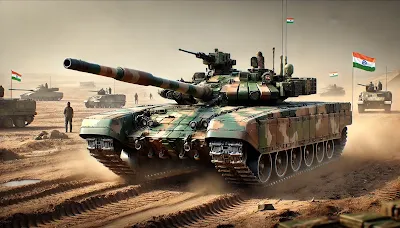Introduction
The T-72 main battle tank (MBT) is one of the most widely used and battle-proven tanks globally. India, operating over 2,400 T-72 tanks, has significantly relied on these armored vehicles for national defense. Recently, India signed a $248 million contract with Russia’s Rosoboronexport to procure 1,000 HP engines, replacing the older 780 HP engines. This upgrade enhances the mobility, speed, and combat efficiency of the T-72 fleet, ensuring they remain relevant in modern warfare.
Development of the T-72 Tank
Originally developed by the Soviet Union in the 1970s, the T-72 has been a core component of many armed forces worldwide.
Designed by Uralvagonzavod, the tank has seen multiple upgrades and modernizations.
India locally manufactures and upgrades its T-72 fleet at the Heavy Vehicles Factory (HVF) in Avadi, Chennai.
Key Features of the T-72 Tank
1. Firepower
Armed with a 125mm smoothbore gun, capable of firing APFSDS (Armor-Piercing Fin-Stabilized Discarding Sabot) rounds.
Equipped with a 7.62mm coaxial machine gun and a 12.7mm anti-aircraft gun.
2. Mobility and Engine Upgrade
The T-72 was originally powered by a 780 HP engine, limiting its maneuverability.
With the latest 1,000 HP engine upgrade, the tank achieves greater speed, endurance, and operational efficiency.
3. Armor Protection
Features composite armor and explosive reactive armor (ERA) to withstand anti-tank missiles and enemy fire.
Enhanced mine and IED protection ensures crew survivability.
4. Night Combat Capability
Equipped with thermal imaging and infrared sights, allowing for effective night operations.
Advanced fire control systems improve target acquisition and accuracy.
5. Operational Range and Endurance
The T-72 can travel 460 km on-road and 300 km off-road using auxiliary fuel tanks.
Designed for high-altitude operations, deployed in Ladakh and desert warfare zones.
Significance of T-72 Tanks in India’s Defense Strategy
1. Backbone of the Indian Army
With 2,400+ units in active service, the T-72 remains the largest tank fleet in the Indian Army.
Essential for rapid deployment and strategic defense in border conflicts.
2. Cost-Effective Modernization
Upgrading T-72 tanks is cheaper than acquiring new MBTs like the T-90 or Arjun.
Ensures combat readiness while reducing operational costs.
3. High-Altitude and Multi-Terrain Capability
Used effectively in Ladakh, Rajasthan, and Punjab, proving adaptable in diverse terrains.
Supports mechanized infantry and armored divisions in offensive and defensive roles.
4. Strengthening India-Russia Defense Relations
The $248 million contract with Rosoboronexport reinforces India’s long-standing defense partnership with Russia.
Includes Transfer of Technology (ToT) to Armoured Vehicles Nigam Limited (AVNL) in Avadi, enhancing India’s defense manufacturing capabilities.
MCQs for UPSC CSE
Which country originally developed the T-72 tank? a) United States
b) Russia (Soviet Union)
c) Germany
d) France
Answer: b) Russia (Soviet Union)How many T-72 tanks are currently in service with the Indian Army? a) 1,000
b) 2,400+
c) 3,500
d) 5,000
Answer: b) 2,400+What is the main gun of the T-72 tank? a) 105mm rifled gun
b) 120mm smoothbore gun
c) 125mm smoothbore gun
d) 130mm anti-tank gun
Answer: c) 125mm smoothbore gunWhat is the new engine power of the upgraded T-72 tanks? a) 780 HP
b) 880 HP
c) 1,000 HP
d) 1,200 HP
Answer: c) 1,000 HPWhere are T-72 tanks manufactured and upgraded in India? a) DRDO, Bangalore
b) Heavy Vehicles Factory (HVF), Avadi
c) Ordnance Factory, Jabalpur
d) BEML, Mysore
Answer: b) Heavy Vehicles Factory (HVF), Avadi
UPSC Mains Question
Q. Discuss the role of the T-72 tanks in India’s defense strategy. Analyze the impact of their modernization on operational effectiveness and strategic preparedness.
Conclusion
The T-72 tank continues to be a vital asset in the Indian Army, offering firepower, mobility, and armored protection. The recent engine upgrade to 1,000 HP enhances its battlefield capabilities, ensuring it remains effective in modern warfare. With strategic high-altitude deployment, cost-effective modernization, and strong Indo-Russian defense collaboration, the T-72 remains a cornerstone of India’s armored warfare strategy.
Also Read:






